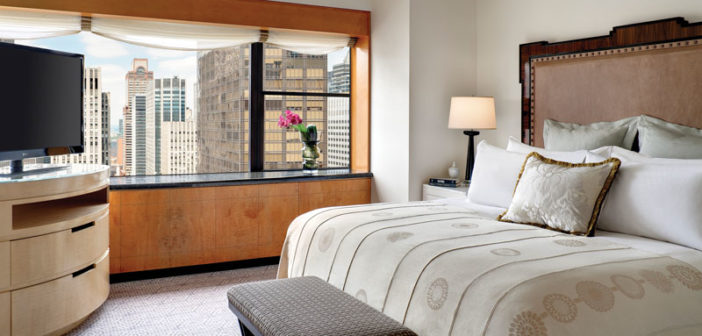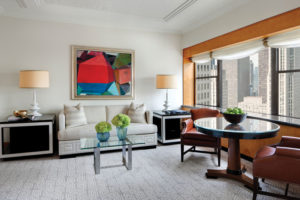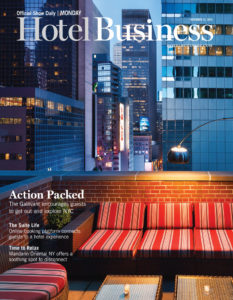NEW YORK—Formerly known as the New York Palace, the Lotte New York Palace Hotel has had renovations over the years, but one of its most recent technological upgrades sought to transform the historic building into a modern-day spectacle.
Real estate investment firm Northwood Investors, who acquired the property from the Sultan of Brunei in 2011 and sold the hotel to Lotte Hotels & Resorts in 2015, decided to renovate the hotel shortly after purchasing it. Technological and sustainability developments were pursued to complement the redesign of the rooms and suites.
“The primary design objectives for the hotel technology were to create a luxury experience for the Palace’s elite clientele,” said Kate Horan, former senior project manager at Jones Lang LaSalle, a Chicago-based real estate firm that represented Northwood Investors during the project. “A great deal was spent on hiring consultants who were the best-of-the-best to design all aspects of this renovation.”
Mode:Green, an integrated building technology solutions firm dedicated to designing and integrating room automation and energy management solutions for the hospitality industry, is one of the companies put in charge of upgrading the hotel’s technology to the 21st century. The company specializes in energy efficiency and data-logging.
“We’ve worked with all of the manufacturers out there,” said Bill Lally, president of Mode:Green, in an interview with Hotel Business. “We know what the offerings are, and we really are in a position where, because we don’t represent any particular manufacturer, we can recommend the best equipment for the job. Our role fundamentally as a company becomes almost of a technology general contractor.”
Mode:Green leveraged existing Cresnet cabling to avoid having to make any alterations to the property’s existing structure. “Any changes in construction or walls being opened up or anything like that was really driven by design and by new layouts,” he noted. The hotel had its IT professionals install technology systems designed by Crestron—a Rockleigh, NJ-based manufacturer of automation and control solutions—in 1992.
“The hotel stack was about 20 years old from its last iteration of technology upgrades, so we were able to take advantage of the infrastructure that had been put in place 20 years ago,” he said.
To enhance the property’s technological features, Mode:Green set up internal wireless gateways by installing a Crestron 3-series Control System, an integrated building-management platform, in each of the hotel’s guestrooms. The Crestron InfiNET EX wireless protocol permits multiple wireless devices to be connected and managed.
“We ended up saving the ownership group a tremendous amount of money from not having to re-cable to upgrade the building to a current system,” Lally said, noting the former owner was adamant about not spending an extraordinary “amount of money on infrastructure changes.” Mode:Green and the hotel saved about $250,000 by doing this.
Another objective for Mode:Green, lowering energy costs for the property. “There was a big energy management component that they weren’t taking advantage of, from being able to dim lighting to being able to track guest occupancy, so from that perspective, the energy component became a big piece, especially in such a large building,” Lally said.
The updated control systems also allow the hotel to lower room temperatures in the winter after a guest checks out or lower window shades in the summer to minimize heat from the sun, thereby assisting with decreasing the property’s overall energy costs.
Establishing a wireless gateway in each room provides guests with ways to control room climate, door locks, window shades and audio. It also opens up various settings for LED lighting. Guests can control every room light with a wall-mounted touch pad.
Guests can lock and unlock doors from a keypad by their bed (made possible by the gateway working in sync with the hotel’s door-locking system, which was designed by Saflok, a South African-based supplier of electronic locking systems for the lodging industry). Bedside, the touch screen can also be used to control Apple devices, change channels on the television and play movies from the hotel’s available video system.
Guests cannot use their own devices to direct actions in the room. “The system we installed is capable of that, but the client chose not to have that functionality,” he said.
Mode:Green also made other upgrades, including automated drapes in the ballrooms, televisions in the new bar and audio-system updates to various public spaces throughout the hotel. “We were involved in most aspects of the renovation,” Lally noted.
Electrical inconsistency of the rooms was an unforeseen obstacle for Mode:Green. “That’s a challenge from a programming aspect of doing lighting controls because if the rooms aren’t consistent, we’re creating customized programs for each,” he said, acknowledging 40-50 room types in the hotel. “We actually haven’t come across this before or since.”
This time-consuming hurdle added additional pressures to an already “extremely aggressive” construction schedule. “With technology, we’re always the last person in the room because everything else has to be in place for us to make our stuff work,” he said.
Learning from its experience with this project, Mode:Green now stages projects off-site, assembling and programming technology components ahead of time, “So, as that schedule slips and slips over time, we don’t really care because we already have everything ready to go,” Lally said. Despite time constraints, the tech company hit its deadlines.
Mode:Green still manages the technology it installed to “make sure that everything is working properly as new guests come in and out.” Maintenance includes regular checkups and monitoring to keep every piece of the system working properly.
“The hotel space is very different than other environments—like corporate offices or residential work—it’s a much more demanding, much more dynamic technology environment,” he said, recognizing the industry’s need for immediate fixes from IT. HB



